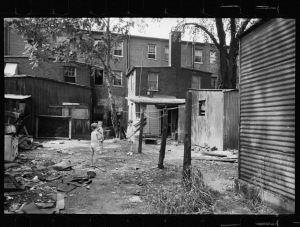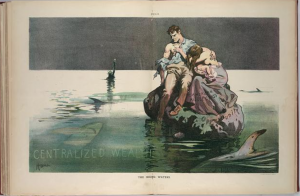Photographs and illustrations are helpful in visualizing what economic inequality looked like from 1880 to 1950. From these primary sources, we can see how people on both sides of the wealth spectrum lived and how they felt about wealth accumulation.
Children in DC Slums, Carl Mydans, 1935

Carl Mydans’ 1935 photograph captures poverty in the Nation’s Capital. The image depicts a slum in Washington DC with young children playing in a yard filled with dirt and debris. The message of the photograph was that poverty was prevalent all over the country, even in the Capital City. This source demonstrates what life was like for families who existed towards the lower end of the wealth spectrum. It is from a collection of photographs by Carl Mydans depicting poverty available from the Library of Congress. Compared to the wealth shown in the next picture, the disparity between the lives of the rich and poor becomes even more apparent.
Newport Mansion, Jack Delano, 1940

This picture of a Gilded Age mansion in 1940 taken by Jack Delano is an example of the excesses of wealth that had been built by this time. Newport Beach was a popular location for new as well as generational wealth in America during the first half of the twentieth century. The house in this picture is Ochre Court, which was built and owned by the wealthy Goelet family. Many houses like this were built during the Gilded Age by those who were able to exploit the industrialization in America. The picture shows the mansion behind its grand wrought iron gates, suggesting it was taken to show the barrier between great wealth and the common man. It also shows what extreme wealth in America looked like in 1940. This image is also from a collection available from the Library of Congress.
The Rising Waters, Carl Hassmann, 1906

This illustration created by Carl Hassmann in 1906 demonstrates the attitude of the American public towards wealth inequality. It depicts a ragged and tattered couple labeled “The American Middle Class” clinging atop a rock labeled “Opportunity.” The rock is barely rising above an ocean labeled “Centralized Wealth,” in this ocean are sharks circling the rock and a Statue of Liberty barely breaking the surface. The representation of the middle class clinging to what little opportunity is left in a rising sea of wealth accumulation is a clear expression of frustration. Similarly, the sharks in the ocean of centralized wealth are likely meant to depict the ultra-wealthy, who are “preying” on the middle class. The Statue of Liberty in the background, almost completely submerged, further represents the diminishing opportunity in the face of extreme inequality and exploitation. From this source, we can see how the majority of Americans were aware and critical of wealth inequality, specifically the accumulation of wealth by the upper class.
